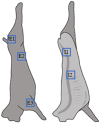Conventionally Reared Wallon Meat Lambs Carry Transiently Multi-Drug-Resistant Escherichia coli with Reduced Sensitivity to Colistin Before Slaughter
- PMID: 39457968
- PMCID: PMC11505500
- DOI: 10.3390/ani14203038
Conventionally Reared Wallon Meat Lambs Carry Transiently Multi-Drug-Resistant Escherichia coli with Reduced Sensitivity to Colistin Before Slaughter
Abstract
Major efforts have been made to reduce the use of colistin in livestock since the discovery of the plasmid-borne mobile colistin resistance (mcr) gene in E. coli a decade ago, to curb the burden of its potential transmission to other bacterial species, spread between animals, humans and the environment. This study explored the longitudinal prevalence and characteristics of colistin-resistant and extended-spectrum beta-lactamase-producing (ESBL) E. coli via in vivo fecal and ex vivo carcass swabs from two batches of conventional indoor and organic outdoor Wallon meat sheep from birth to slaughter in 2020 and 2021. Antimicrobial susceptibility testing via broth microdilution revealed that n = 16/109 (15%) E. coli isolates from conventional meat lamb fecal samples had a reduced colistin sensitivity (MIC = 0.5 μg/mL) and thereof, n = 9/109 (8%) were multi-drug-resistant E. coli, while no resistant isolates were recovered from their carcasses. Sequencing revealed causative pmrB genes, indicating that the reduced sensitivity to colistin was not plasmid-borne. While the sample size was small (n = 32), no colistin-resistant and ESBL-producing E. coli were isolated from the organic meat sheep and their carcasses, potentially due to the different husbandry conditions. Prudent and judicious antimicrobial use and strict slaughter hygiene remain imperative for effective risk management to protect consumers in a sustainable One Health approach.
Keywords: E. coli; ESBL; MDR; colistin; meat lamb; sheep.
Conflict of interest statement
The authors declare no conflicts of interest.
Figures


Similar articles
-
Abundance of colistin-resistant Escherichia coli harbouring mcr-1 and extended-spectrum β-lactamase-producing E. coli co-harbouring blaCTX-M-55 or -65 with blaTEM isolates from chicken meat in Vietnam.Arch Microbiol. 2022 Jan 15;204(2):137. doi: 10.1007/s00203-021-02746-0. Arch Microbiol. 2022. PMID: 35032196
-
Prevalence of colistin resistance and mcr-1/mcr-2 genes in extended-spectrum β-lactamase/AmpC-producing Escherichia coli isolated from chickens in Canada, Senegal and Vietnam.J Glob Antimicrob Resist. 2019 Dec;19:222-227. doi: 10.1016/j.jgar.2019.05.002. Epub 2019 May 14. J Glob Antimicrob Resist. 2019. PMID: 31100501
-
Antibiotic resistance and detection of plasmid mediated colistin resistance mcr-1 gene among Escherichia coli and Klebsiella pneumoniae isolated from clinical samples.Gut Pathog. 2021 Jul 5;13(1):45. doi: 10.1186/s13099-021-00441-5. Gut Pathog. 2021. PMID: 34225805 Free PMC article.
-
Occurrence of the Colistin Resistance Gene mcr-1 and Additional Antibiotic Resistance Genes in ESBL/AmpC-Producing Escherichia coli from Poultry in Lebanon: A Nationwide Survey.Microbiol Spectr. 2021 Oct 31;9(2):e0002521. doi: 10.1128/Spectrum.00025-21. Epub 2021 Sep 8. Microbiol Spectr. 2021. PMID: 34494875 Free PMC article.
-
Colistin resistance in ESBL- and Carbapenemase-producing Escherichia coli and Klebsiella pneumoniae clinical isolates in Cambodia.J Glob Antimicrob Resist. 2024 Sep;38:236-244. doi: 10.1016/j.jgar.2024.06.017. Epub 2024 Jul 14. J Glob Antimicrob Resist. 2024. PMID: 39004342
References
Grants and funding
LinkOut - more resources
Full Text Sources

